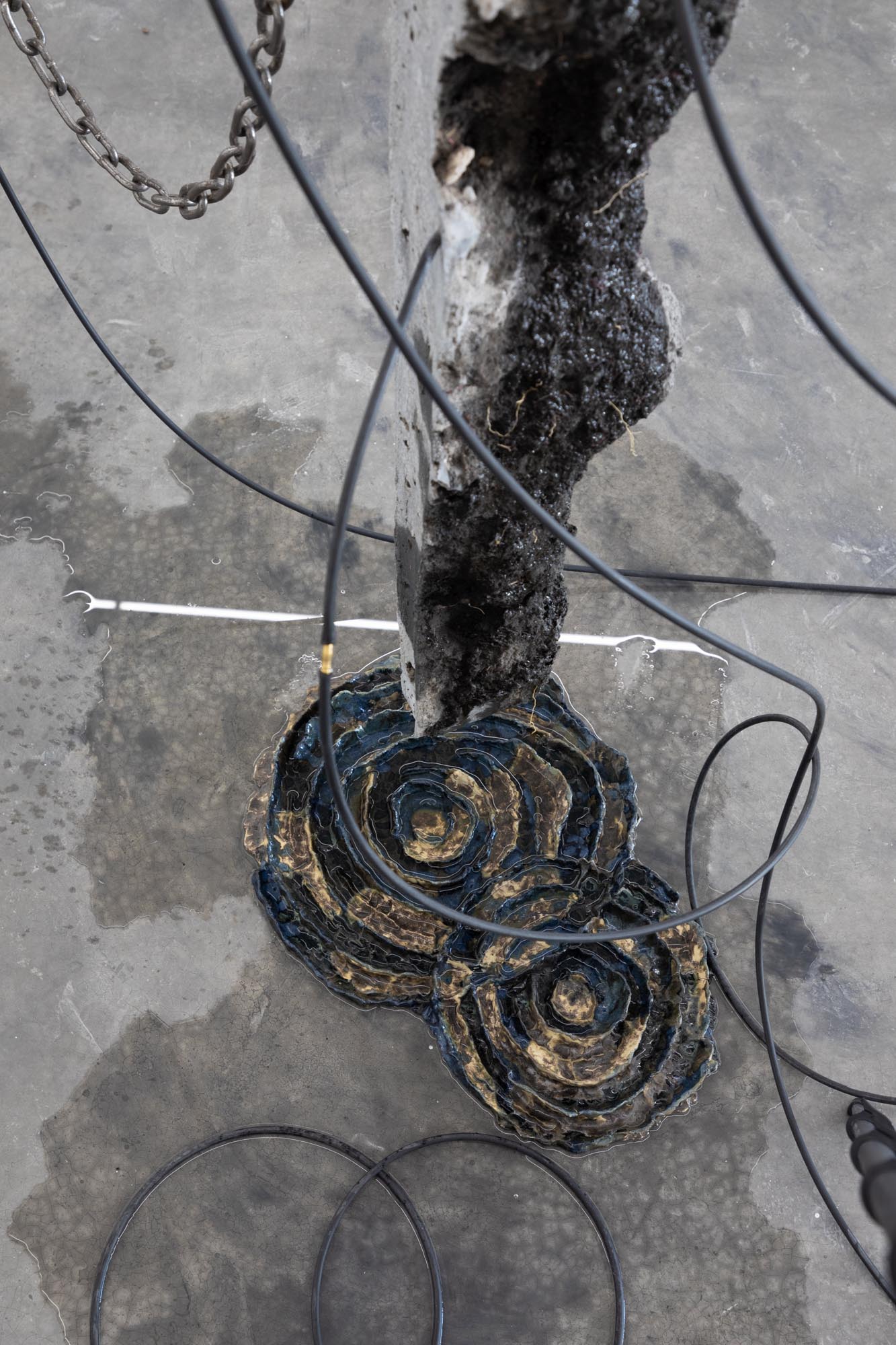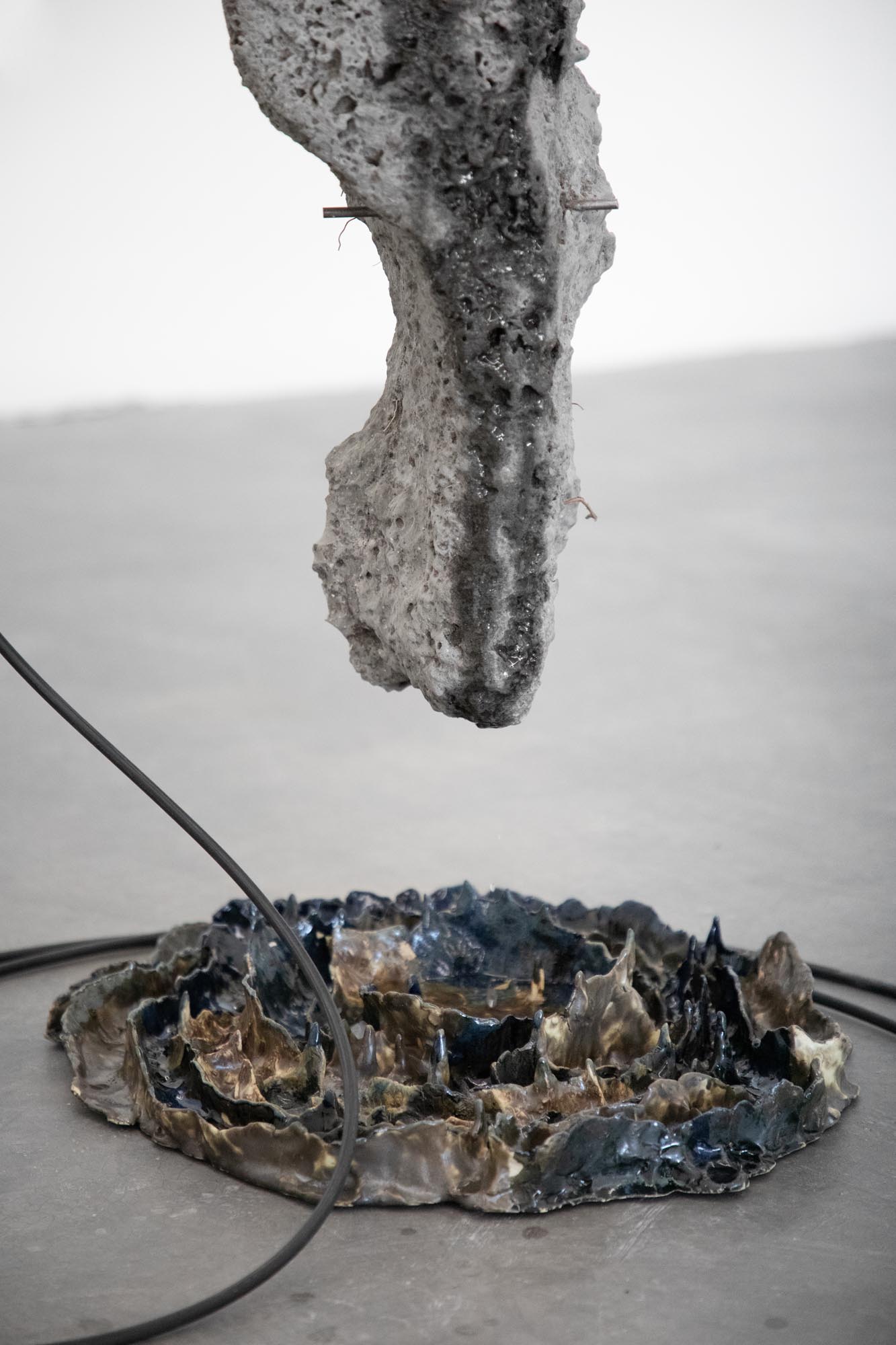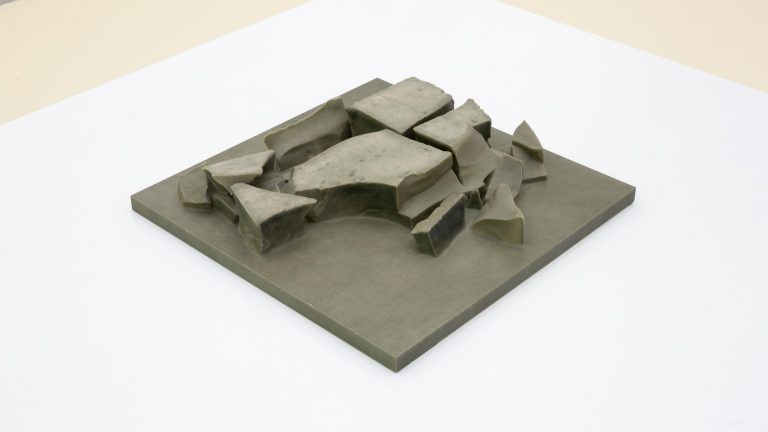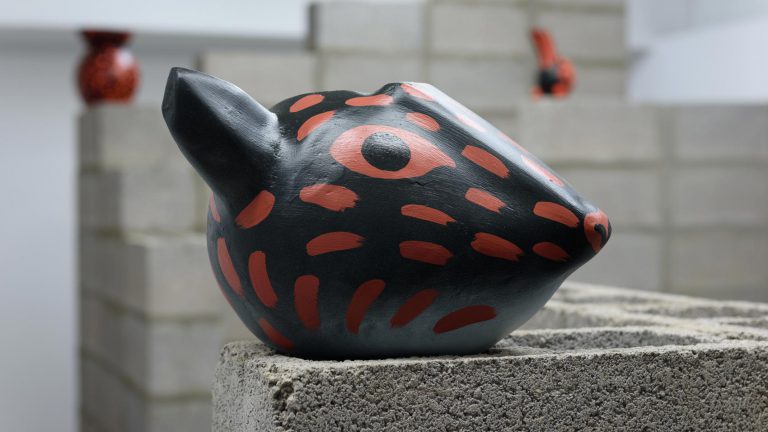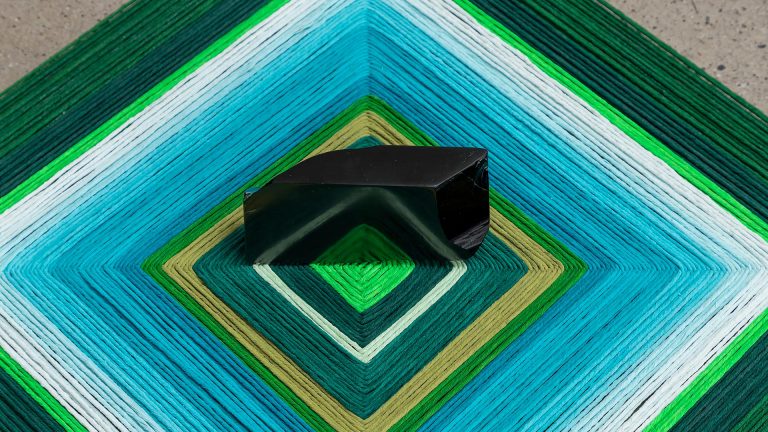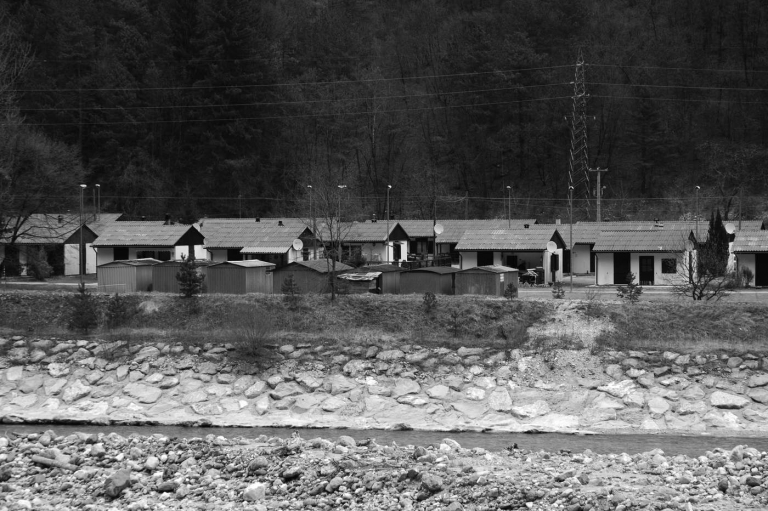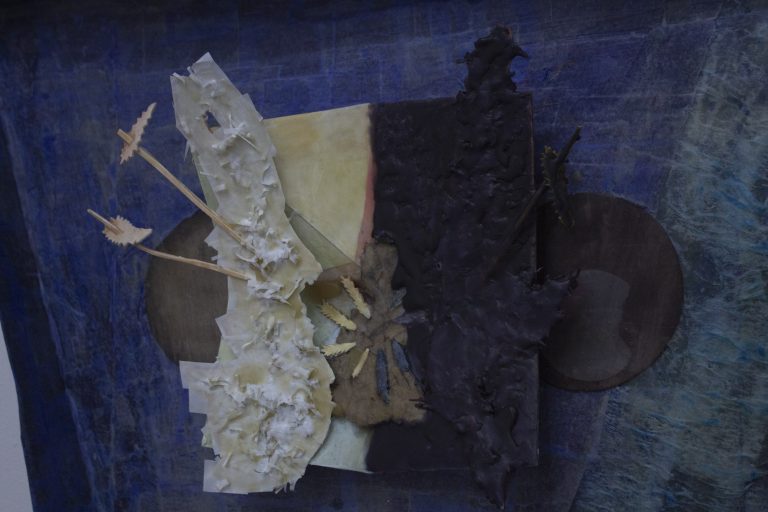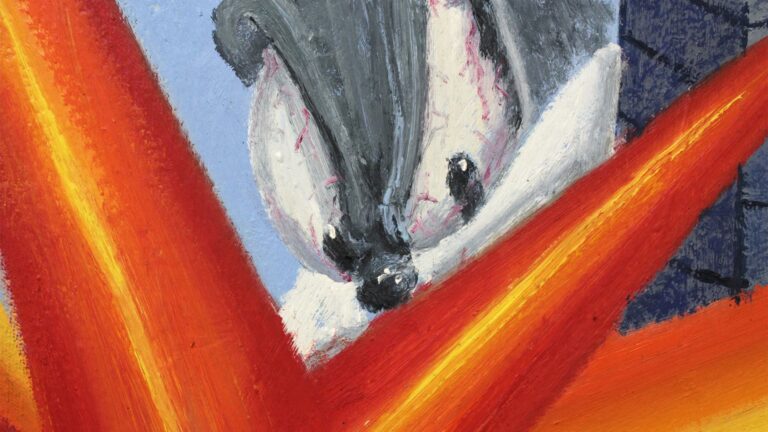Artist: Tomás Díaz Cedeño
Exhibition title: Usando este cuerpo, pensando en la fuente
Venue: Peana Projects, Monterrey, Mexico
Date: March 27 – May 6, 2019
Photography: all images copyright and courtesy of the artist and Peana Projects, Monterrey
The new monuments seem to cause us to forget the future.
-Robert Smithson
The proportion between the natural and the artificial, as well as the continuous interaction between empirical belief systems and scientific methodologies, constitute the central axis of the artistic production of Tomás Díaz Cedeño (Mexico City, 1983). “Using this body, thinking of the fountain.” is part of this dichotomy, providing a compendium of seven sculptural installations whose physical approach is based on the artist’s drawings and studies, transformed through the use of different materials, textures, objects and images that offer keys to reflect on the artist’s relationship with three main arguments: landscape, architecture and textiles.
What circumstances and attitudes can be adopted in favor of the guarantee of nature from the perception of the creative genesis? What relevance does this interaction acquire in the current local and international production? Díaz Cedeño appropriates these questions as a starting point for an analysis of the artist’s relationship with the landscape. From a formal approach and with an emphasis on the sculptor’s craft, the artist transforms the exhibition space into a sort of underground cave. Five structures made of concrete poured into the ground form the basis of the sculptural installation “1000 years”. In a kind of energetic union that complements the biological-mineral cycle, an irrigation system activates and connects each sculpture, allowing drops of water to fall from the upper part and onto ceramic bases at their end. The relationship with the formation of stalagmites is not casual, the title refers to the time it takes these unique mineral structures to grow 10 cm. The artificial manufacturing cycle is complemented by the vaporization of essences from four trees2: capulin, ahuehuete, tepozan and white willow. The metamorphosis of the gallery is fine-tuned with the piece “Usando este cuerpo”, an anthropomorphic arrangement that contends the position of the human being as part of a complex system of matter and energy.
The maquette, a meta-artificial and abstract model of the space, exposes the construction of systems that attest to the naturalness of the synthetic. In this context, architecture is inscribed as a theatre in which rituals of preservation and survival are carried out. “Paisaje” proposes the construction of a ceramic model of the gallery as a partial reality in which the underground cave completely takes over the space and in which the environment is complemented face-to-face with the anthropocentric construction.
In a symbolic language, the formation of these hybrid beings goes back to the intervals of the psyche. In “Powers of Horror”, Julia Kristeva defines abject as a state in which everything that encompasses identity and systemic order is disturbed. A “primordial order” that explores the transgressive and threatens our definition and sense of property and hygiene. While abjection is generated in the perception of human fluids, it also involves the use of akin materials such as water (as a biotic activator) or objects that provoke a physical and mental reaction of horror and desire altogether. “Strap On” and “Camino con varas de huizache” become abject objects that reflect the vulnerability of human beings in the face of pain and pleasure, the limits between the animal and the cognitive. In these, Díaz Cedeño continues with previous lines of work in which he analyzes the fetishism of everyday objects and proposes the deconstruction and neutralization of these through their symbolic and material transformation.
Finally, textile is proposed as an extension of the body in the same measure that landscape and architecture generate new dynamics with other elements of their surroundings. “Petate I-IV” is a set of pieces made of recycled aluminium that present the act of sewing in the pattern of the textile’s own palm fibres. The petate and other traditional utilitarian textiles have a close relationship with the identity of their communities not only because of their traditional use but also because of the origin of the material with which they are made. Palm, jute, henequen and other natural fibers are linked both to a specific landscape and to an industry that allows or allowed their exploitation. It is in these industries that a dynamic with bodies subordinated through labour is inscribed, acquiring a specific political and economic context.
Díaz Cedeño’s atmosphere is constructed between reality and science fiction, in a timeless space in which scientific references intertwine with those of alternative belief systems. However, the formation of these objects is based on rituals closer, more real and essential for the understanding of the relationship between human beings and their environment.
-Alberto Ríos de la Rosa
1.Research and production of olfactory materials by PANOSMICO collective
Tomás Díaz Cedeño, Usando este cuerpo, pensando en la fuente, 2019, exhibition view, Peana Projects, Monterrey
Tomás Díaz Cedeño, Usando este cuerpo, pensando en la fuente, 2019, exhibition view, Peana Projects, Monterrey
Tomás Díaz Cedeño, Usando este cuerpo, pensando en la fuente, 2019, exhibition view, Peana Projects, Monterrey
Tomás Díaz Cedeño, Usando este cuerpo, pensando en la fuente, 2019, exhibition view, Peana Projects, Monterrey
Tomás Díaz Cedeño, 1000 años, 2019, Five concrete sculpture installation, floor water pump, glazed stoneware ceramic, aluminium, hoses, Variable dimensions
Tomás Díaz Cedeño, 1000 años, 2019, Five concrete sculpture installation, floor water pump, glazed stoneware ceramic, aluminium, hoses, Variable dimensions
Tomás Díaz Cedeño, 1000 años, 2019, Five concrete sculpture installation, floor water pump, glazed stoneware ceramic, aluminium, hoses, Variable dimensions
Tomás Díaz Cedeño, 1000 años, 2019, Five concrete sculpture installation, floor water pump, glazed stoneware ceramic, aluminium, hoses, Variable dimensions
Tomás Díaz Cedeño, 1000 años, 2019, Five concrete sculpture installation, floor water pump, glazed stoneware ceramic, aluminium, hoses, Variable dimensions
Tomás Díaz Cedeño, 1000 años, 2019, Five concrete sculpture installation, floor water pump, glazed stoneware ceramic, aluminium, hoses, Variable dimensions
Tomás Díaz Cedeño, 1000 años, 2019, Five concrete sculpture installation, floor water pump, glazed stoneware ceramic, aluminium, hoses, Variable dimensions
Tomás Díaz Cedeño, Usando este cuerpo, pensando en la fuente, 2019, exhibition view, Peana Projects, Monterrey
Tomás Díaz Cedeño, Usando este cuerpo, pensando en la fuente, 2019, exhibition view, Peana Projects, Monterrey
Tomás Díaz Cedeño, Usando este cuerpo, pensando en la fuente, 2019, exhibition view, Peana Projects, Monterrey
Tomás Díaz Cedeño, Usando este cuerpo, pensando en la fuente, 2019, exhibition view, Peana Projects, Monterrey
Tomás Díaz Cedeño, Paisaje, 2019, Glazed stoneware ceramic, aluminium base, 18 x 54.5 x 45 cm., 7 x 21.4 x 17.7 in.
Tomás Díaz Cedeño, Paisaje, 2019, Glazed stoneware ceramic, aluminium base, 18 x 54.5 x 45 cm., 7 x 21.4 x 17.7 in.
Tomás Díaz Cedeño, Usando este cuerpo, pensando en la fuente, 2019, exhibition view, Peana Projects, Monterrey
Tomás Díaz Cedeño, Paisaje II, 2019, *Research and production of olfactory materials by PANOSMICO collective Nebulizer, capulin, ahuehuete, tepozan and white willow essences, 127 x 60 x 60 cm., 50 x 24 x 24 in.
Tomás Díaz Cedeño, Usando este cuerpo, pensando en la fuente, 2019, exhibition view, Peana Projects, Monterrey
Tomás Díaz Cedeño, Camino con varas de huizache I, 2019, Glazed stoneware ceramic, aluminium, ribbon, 66 x 15 cm., 25 x 5.9 in.
Tomás Díaz Cedeño, Camino con varas de huizache III, 2019, Glazed stoneware ceramic, aluminium, lycra mesh, 51 x 30 cm., 20 x 11.8 in.
Tomás Díaz Cedeño, Petate I, 2019, Aluminium, wax thread, 40 x 40 x 5 cm., 15.7 x 15.7 x 2 in.
Tomás Díaz Cedeño, Petate II, 2019, Aluminium, wax thread, 40 x 40 x 5 cm., 15.7 x 15.7 x 2 in.
Tomás Díaz Cedeño, Petate III, 2019, Aluminium, 40 x 40 x 5 cm., 15.7 x 15.7 x 2 in.
Tomás Díaz Cedeño, Strap on, 2019, Soil, plaster, brass powder, leather, thread, 174 x 40 x 50 cm., 68.5 x 15.7 x 19.6 in.
Tomás Díaz Cedeño, Strap on, 2019, Soil, plaster, brass powder, leather, thread, 174 x 40 x 50 cm., 68.5 x 15.7 x 19.6 in.
Tomás Díaz Cedeño, Usando este cuerpo, 2019, Concrete, copper, 110 x 80 x 50 cm., 43.3 x 31.4 x 19.6 in.







